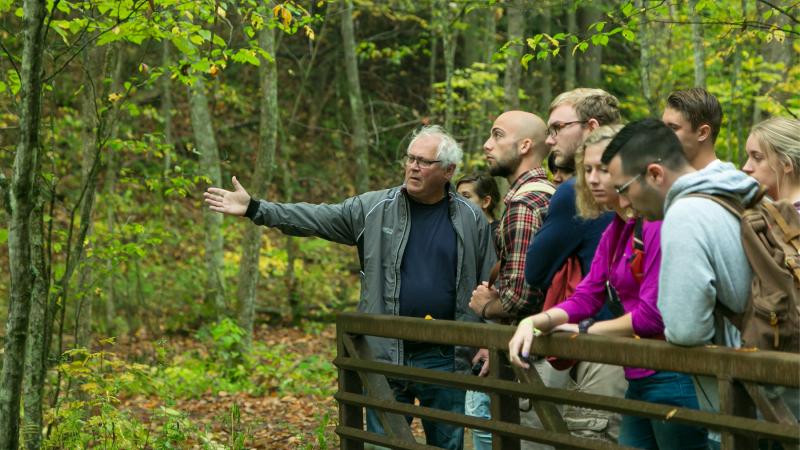Recording the Landscape with Roland Gustavsson
Along the trail into the Conkle’s Hollow State Nature Preserve, Roland Gustavsson directed the attention of Knowlton School landscape architecture students to a stand of yellow birch along the escarpment of the south gorge wall. Around the grove of birch trees, another species crowded in; tulip poplars rose over one hundred feet and had begun to shade out the growth below. Gustavsson, the 2016 Trott Distinguished Visiting Professor at the Knowlton School, pointed out that the birch trees were surviving by strength in numbers, creating a colony of enough density and width to stop the encroachment of the poplars and prevent their canopy from closing out the light.
This moment of attention to the competition between tree species is at the center of Gustavsson’s research and writing at the Swedish University of Agricultural Studies. It also informed the three days of field visits Gustavsson conducted with sophomore and first-year graduate landscape architecture students: identify four reference landscapes in Central Ohio and document, through field sketches and photographs, the relation and interaction of plant species within selected two-hundred-foot transects. At visits to Walnut Woods Metro Park, Cedar Bog Nature Reserve, Battelle Darby Creek Metro Park, and Conkle’s Hollow, students recorded details within their chosen sections, such as the habits or forms of certain trees responding to the presence of different environmental conditions, and how changes in micro-topography may result in aberrations in plant growth.

Katherine Jenkins, assistant professor of landscape architecture and instructor of the first-year graduate landscape architecture student design studio, indicates that field sketching is a valuable exercise for beginning designers because it teaches the critical skill of observation: “Hand drawing requires the drawer to continuously make decisions about what she is editing out and what she is including. The drawer is making a series of judgments about the landscape she is recording, and that assessment is critical to informing her design response.”
Gustavsson has been using profile drawings as a technique to document forest-specific landscapes for over 35 years. His method requires annual visits to specific sites where he will spend days meticulously drawing the trees, accumulating over many years the social relationship of them. This rigor and intention over a long duration provide insights into how trees compete with one another for space, how species change according to their proximity to each other, and the relationship between canopy and understory.
Jake Boswell, assistant professor of landscape architecture and coordinator of the week-long Trott Professor workshop, points to the Lucks/Kass Bosque that borders the east patio of Knowlton Hall as an example of why understanding the dynamics of these interactions is essential to the practice of landscape architecture: “For designers, understanding the relationships of trees relative to one another—how they react to light differently, how they react to crowding differently—allows us to produce different effects regarding their form. The bosque has a large, arching canopy which is influenced by their specific on-center dimensions relative to one another.” Long-term studies such as Gustavsson’s profile drawings bear out tree characteristics that make designing spaces more informed.
Moving from observation to analysis, students created large profile diagrams on paper with charcoal and chalk from one of their documented transects during a two-day exercise in Knowlton Hall. Students worked in groups of three or four, and faced the challenges of deciding the scale of their drawing and how to produce within a team one drawing that is coherent and cohesive. Sketching on paper that measures over six feet horizontally and five feet vertically is useful as Jenkins states: “It requires you to use your whole body. You are moving around, you are getting up and sitting down, you’re using your whole arm.” As such, Jenkins suggests that drawing at this large scale serves as a continuation of Gustavsson’s approach to move through and engage with the landscape physically and mentally.

The completed drawings reveal how students are able to edit and abstract complexities within the ecological conditions of their transects into seemingly simple hand-drawn representations. Located between the interstitial spaces of the Knowlton Hall ramp, selected drawings are currently hung for display.
Roland Gustavsson’s Trott Distinguished Visiting Professor residency at the Knowlton School also included a visit during the spring semester when he engaged with students in the landscape architecture design studio and a keynote presentation at the THIS IS A TEST: Landscape as Site for Research symposium, hosted by the school’s Landscape Architecture Section.
Gustavsson’s career in landscape architecture, as a researcher and teacher, began in Sweden in 1976. After obtaining his PhD in 1987, as only the second landscape architect in Sweden with a doctorate, his ambition was to pioneer a bridge between academia and practice through a position at the university. In 1994 he was appointed Professor in Planting Design and Landscape Management at the Department of Landscape Planning at the Swedish University of Agricultural Sciences (SLU).
He is a member of the European network group Periscapes, employing the ‘landscape ambassador’ approach based on Real Life Studios stressing communicative approaches and the meeting of different landscape competences and cultures of Europe. His articles have been published in Urban Forestry & Urban Greening, Forest Policy and Economics and Landscape Ecology, among others.


